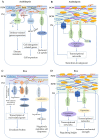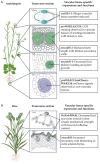Function of WAKs in Regulating Cell Wall Development and Responses to Abiotic Stress
- PMID: 39942905
- PMCID: PMC11820136
- DOI: 10.3390/plants14030343
Function of WAKs in Regulating Cell Wall Development and Responses to Abiotic Stress
Abstract
Receptor-like kinases (RLKs) are instrumental in regulating plant cell surface sensing and vascular tissue differentiation. Wall-associated kinases (WAKs) are a unique group of RLKs that have been identified as key cell wall integrity (CWI) sensors. WAK signaling is suggested to be activated during growth in response to cell expansion or when the cell wall is damaged, for example, during pathogen attack. WAKs are proposed to interact with pectins or pectin fragments that are enriched in primary walls. Secondary walls have low levels of pectins, yet recent studies have shown important functions of WAKs during secondary wall development. Several wak mutants show defects in secondary wall thickening of the xylem vessels and fibers or the development of vascular bundles. This review will discuss the recent advances in our understanding of WAK functions during plant development and responses to abiotic stresses and the regulation of vascular tissue secondary wall development.
Keywords: cell wall integrity (CWI); oligogalacturonides; pectin; primary cell wall (PCW); secondary cell wall (SCW); wall-associated kinase (WAK).
Conflict of interest statement
The authors declare no conflicts of interest.
Figures


Similar articles
-
The Role of Brachypodium distachyon Wall-Associated Kinases (WAKs) in Cell Expansion and Stress Responses.Cells. 2020 Nov 14;9(11):2478. doi: 10.3390/cells9112478. Cells. 2020. PMID: 33202612 Free PMC article.
-
WAKs: cell wall-associated kinases linking the cytoplasm to the extracellular matrix.Plant Mol Biol. 2001 Sep;47(1-2):197-206. Plant Mol Biol. 2001. PMID: 11554472
-
Characterization and expression analysis of wall-associated kinase (WAK) and WAK-like family in cotton.Int J Biol Macromol. 2021 Sep 30;187:867-879. doi: 10.1016/j.ijbiomac.2021.07.163. Epub 2021 Jul 31. Int J Biol Macromol. 2021. PMID: 34339786
-
Cell wall-associated kinases and pectin perception.J Exp Bot. 2016 Jan;67(2):489-94. doi: 10.1093/jxb/erv467. Epub 2015 Oct 27. J Exp Bot. 2016. PMID: 26507892 Review.
-
Cell Wall Integrity Signaling in Fruit Ripening.Int J Mol Sci. 2023 Feb 17;24(4):4054. doi: 10.3390/ijms24044054. Int J Mol Sci. 2023. PMID: 36835462 Free PMC article. Review.
Cited by
-
ZmWAK3-mediated cell wall remodeling and stomatal dynamics modulate drought tolerance in maize seedlings.Theor Appl Genet. 2025 Sep 13;138(10):249. doi: 10.1007/s00122-025-05019-2. Theor Appl Genet. 2025. PMID: 40944734
References
-
- Doblin M.S., Ma Y. Plant Cell Walls: Research Milestones and Conceptual Insights. 1st ed. CRC Press; Boca Raton, FL, USA: 2023. pp. 1–28.
Publication types
Grants and funding
LinkOut - more resources
Full Text Sources

